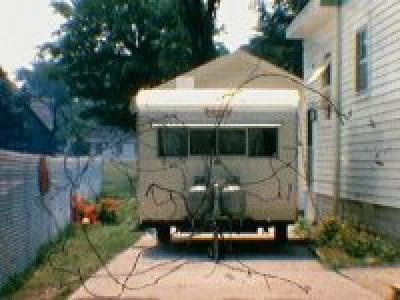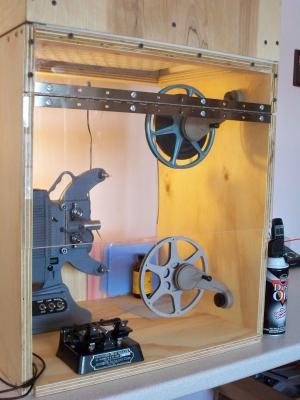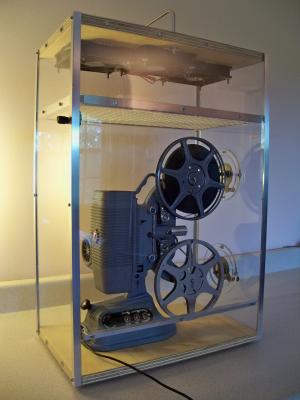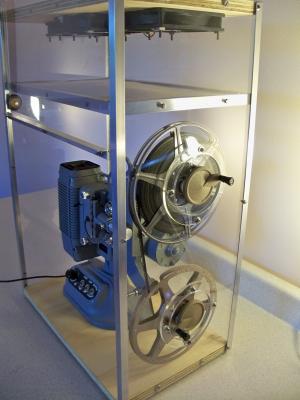Clean Room
 Once the machine was getting nice captures, I started to pay attention to dirt on the film. Dad’s movies are in pretty good condition – they were always stored in metal cans and we were careful when projecting them – but the air is full of dust and there is just no way to keep it from hopping on to the film. This frame was not doctored in Paint – that’s genuine lint and I didn’t put it there on purpose! I’m using a DeSpot software filter in AviSynth to clean up the captured frames, and it works well, but it can’t remove everything without messing up real image. So the first line of defense is to clean the film and keep it clean while doing the telecine transfer.
Once the machine was getting nice captures, I started to pay attention to dirt on the film. Dad’s movies are in pretty good condition – they were always stored in metal cans and we were careful when projecting them – but the air is full of dust and there is just no way to keep it from hopping on to the film. This frame was not doctored in Paint – that’s genuine lint and I didn’t put it there on purpose! I’m using a DeSpot software filter in AviSynth to clean up the captured frames, and it works well, but it can’t remove everything without messing up real image. So the first line of defense is to clean the film and keep it clean while doing the telecine transfer.
I built a clean booth, a cheap substitute for the fancy laminar flow hoods that are used in laboratories and factories to keep dust particles out of precision equipment during assembly. The idea is to blow clean air down across the work area and out the door, carrying dust and lint away from the film. I mounted some editing rewinds to the side of the booth to use when cleaning the film. The supply reel goes on top. Cleaning is done in two passes; in the second pass, the film is wound upward back onto the supply reel, and dust is wiped off and down. The supply reel is then transferred to the telecine spindle, all at the top of the booth where the filtered air is entering.
Four computer fans in the top box blow air straight down through a “dust and pollen” furnace filter. An “allergen” filter or HEPA filter is not necessary for this job, since particles smaller than 10 microns would never be visible to the camera anyway. The biggest culprits are the biggest airborne particles, mostly lint from clothing and carpets. Finer filters also restrict the flow more, and we want the most breeze to sweep dust out of the booth.
The booth has solved the dust problem completely. Now I might see visible bits of lint on 2 or 3 frames out of a 400′ reel, and the old problem of fibers that get caught in the projector gate and have to be removed is eliminated. The DeSpot filter and temporal degraining done in AviSynth handle whatever smaller particles remain, resulting in an amazingly clean final video.
After transferring a few hours of film, and living with this cabinet in the bedroom for several months, I realized what a monstrosity it was and decided to make a leaner one. The old cabinet is too big and heavy to move around, or even to easily set in a corner when not in use. Cleaning film while reaching up inside the door to turn the rewinds is pretty awkward. And the big plywood box is just plain ugly.
So, enter the less-is-more clean cabinet…
With all acrylic sides, there’s more light inside, it’s easier to see what I’m doing, and it looks a lot neater. The box is less than half the size of the old one, and so much lighter that I can carry the cabinet with the telecine in it with one hand by the handle on top. So it’s easy to put it away when I’m done. The door slides open vertically and is held at any position by a little eccentric rubber tire at the side. And now the door can be closed completely to keep dust out when the fans aren’t running. The filter is a cut-to-size air conditioner filter supported by a piece of suspended ceiling eggcrate light diffuser.
This time, I mounted the rewinds in the side wall, so the cranking hand is outside and comfortable, and I’m facing the film and can inspect it more easily…



